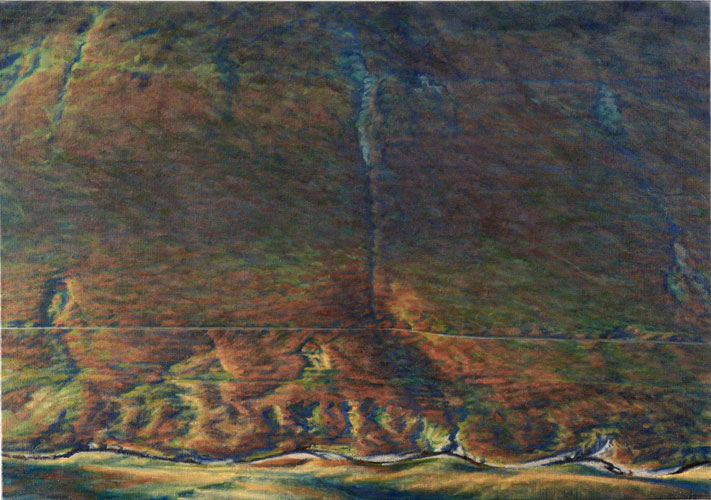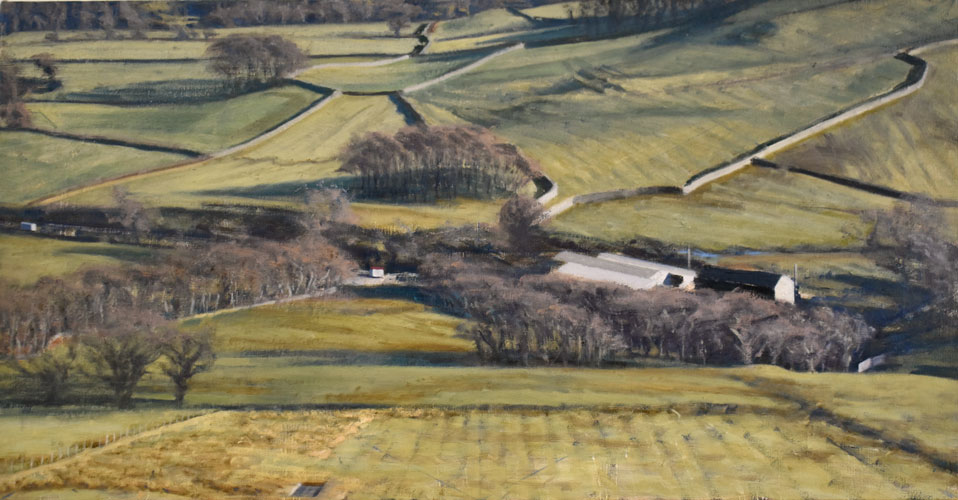LINES OF DESCENT
AN ESSAY BY JULIAN COOPERBACK

When I walk around this landscape in which I grew up and know best, especially now in the hills of the Northern Lakes, I constantly find sights which stop me in my tracks.
These aren’t really the ‘views’ seen in the publicity and marketing of the Lake District. Rather they are the landscape seen through a lens of painting possibilities - of paintings that might be made and which I feel compelled to make, the likes of which I haven’t seen before and which haven’t been made yet.

The template in my head seems to be a kind of abstraction - the two-dimensional division of the space of a rectangle - but using what I see out there on a semi-vertical hillside, translating it into paint and onto the picture surface.
The views that I come across when walking at mid-height on the fells usually contain extraneous material that isn’t really what’s making them exciting and full of promise, so the first task is to identify the essential elements and enlarge upon them only. There’s an idea hiding in there somewhere. Part of what’s engaging me in what I see out in the landscape is an unconscious selection filtered by my own internalised knowledge of painting’s long history, and also my own formative relationship to the particular period of modernism, mainly abstract-expressionism and post-painterly abstraction, that was most prevalent and to which I was most exposed when young.

I’m drawn to the possibilities of translating the colours and shapes I see out there in this vertical landscape into novel paint and colour combinations, stretched by the demands of the subject.
I tend to become fixated on certain places and viewpoints, for instance in the three Across the Lake paintings I felt compelled to focus in on a particular shape of scree and its relationship to the surrounding land and its zones of vegetation, ending abruptly in the lake, from three different distances and heights.
With the Mine Track paintings it was from two adjacent positions moving up the valley, with vertical watercourses ending down at the horizontal river.
The two Grasmoor paintings show the same view of the west face of the mountain but at different times of day.

Woven into this visual thread is an economic and philosophic one involving a debate about the future of the uplands and its uses, the contest between the wild and the cultivated, which is currently contentious both locally and universally, involving greater questions about the natural world and its relationship to human activities.
This transforms a familiar and much visualised landscape into a contested one, something much more interesting to me with that added layer of meaning.

Looking across at a fell-side at mid-height from above a valley, what’s in plain sight is the gradual transition downwards from wild crags and screes near the summits, down zones of altitude through intermediate marginal land, then descending to pasture or lake at valley level.
I’ve become interested in this interplay between nature and culture acted out in a clearly visible way, and how the workings of farming and mining so evident in the landscape also function as physical memory traces on the land surface.
Sometimes when I’m working nearby I come across or see in the distance the figure of Dave Allen, who farms at High Nook Farm, and on who’s land many of the paintings in this exhibition are set.

One meaning of the title ‘Lines of Descent’ refers to the way farming families here are typically descended from their farming ancestors in neighbouring valleys.
The sheep too are ancestrally descended - ‘hefted’ onto the same part of the fell for generations.
Another reference in the title is how linear so many of the features of the landscape are - becks, stone walls, fences, animal and human tracks.
‘Descent’ is also gravity - evident in everything seen - but particularly so in the screes, becks, and tracks, all gravitating towards lake and valley level, and so to the bottom of the picture.
This gives an extra significance to the top and the bottom of the canvas I’m working on, so that it’s both a physical object in front of me, and at the same time an analogue of an actual piece of land.
The idea of descent continues in the close up paintings of becks and of collapsing earth-banks, and of rock plunging deep under the water, its’s nature changing from rough to smooth when submerged, acted on by centuries of water moving past.
The split-level view above and below the waterline was something I at first imagined, and then was made tangible with the help of John Macfarlane’s photographs, taken with his special equipment, and with whom I collaborated over many months. His grand-daughter Iona served as the model for the swimmer in Deep Pool.

I’ve always been drawn towards making sculpture, perhaps influenced by my mother being a sculptor, but also by the rock faces themselves, which lend themselves as a source of interesting new forms promising to extend the language of sculpture a little, or at least of bas-relief.

Of course ‘Lines of Descent’ can also be seen as a reference to the fact of me being the third generation of my family to be painting this particular landscape. Both my father and grandfather spent the majority of their lives depicting the Lake District, and I avoided following them for many years, not wishing to perpetuate what I could only see as a banal continuation of someone else’s vision. However, in recent years I’ve found my own way of seeing this landscape, influenced no doubt by the various mountain regions throughout the world where I’ve worked, and now am happy to discover that this place on my doorstep is now so full of promise.
Julian Cooper 2022